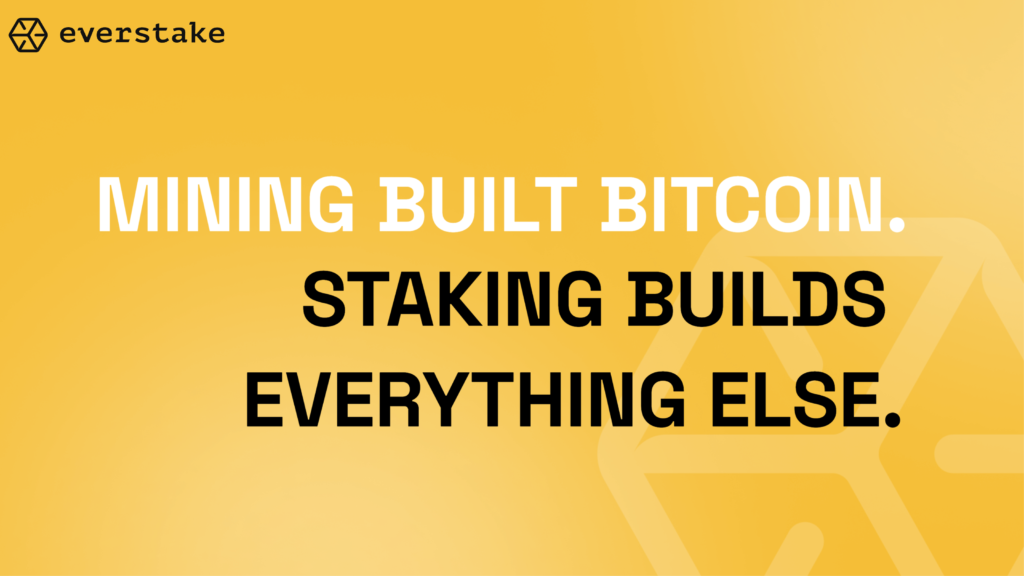The crypto scene in 2025 looks nothing like it did a few years ago. Back then, mining was the backbone of blockchain: loud rigs, high electricity bills, and the promise of freshly minted coins. Today, most of that noise has faded. Proof-of-Stake networks have taken over, turning “supporting the network” from a hardware race into a matter of participation and trust.
For anyone still wondering about the difference between staking and mining or what makes staking vs mining crypto such a big shift, the answer lies in how the entire ecosystem matured. What used to be a competition for computing power has become a coordination of validators. And the change isn’t just technical: it’s cultural, environmental, and economic.
How Mining Works: Proof-of-Work Explained
Before staking became mainstream, mining was the backbone of most blockchains. It’s the process that keeps networks like Bitcoin running by verifying transactions, securing the chain, and creating new coins as rewards.
At its core, mining is based on the Proof-of-Work (PoW) consensus mechanism. In PoW systems, miners compete to solve complex mathematical puzzles using specialized computers, known as ASICs or GPUs. The first miner to find the correct solution gets to add a new block to the blockchain and receive a block reward, which includes both newly minted coins and transaction fees.
This process ensures that every block is verified through computational effort, making it extremely difficult and expensive for any malicious actor to alter the blockchain’s history. That’s what gives PoW its strong security and decentralization.
However, mining comes with major trade-offs:
- High energy consumption. Mining farms consume vast amounts of electricity, sometimes comparable to small countries.
- Expensive hardware. Competitive mining requires powerful, costly equipment that quickly becomes outdated.
- Limited accessibility. For newcomers, joining the mining ecosystem can be technically and financially challenging.
As environmental concerns and efficiency demands grew, new networks looked for sustainable alternatives. And that’s where Proof-of-Stake changed the game.
How Staking Works: Proof-of-Stake and the New Era
Proof-of-Stake secures blockchains not through computing power but through economic commitment. Validators lock (stake) tokens to participate in block production and transaction validation. Instead of competing with hardware, they’re chosen based on their staked amount, uptime, and performance.
Both validators and delegators (those who delegate tokens to validators) earn staking rewards, typically shown as an annual percentage rate (APR). These rewards depend on validator reliability, total staked supply, and network parameters.
Staking brought several transformative benefits:
- Energy efficiency. Staking consumes minimal energy compared to mining, since it doesn’t require continuous hardware operation.
- Accessibility. Anyone can participate using a crypto wallet, often with no minimum requirements.
- Network scalability. PoS systems can process transactions faster and more efficiently.
Prominent examples of PoS blockchains include Ethereum, Solana, Cardano, and NEAR. In fact, Ethereum’s shift from PoW to PoS in 2022 marked one of the most significant milestones in blockchain history, reducing the network’s energy consumption by over 99%.
Proof-of-Stake has since become the default standard for new blockchain projects, setting the stage for a more inclusive and eco-friendly crypto ecosystem.
Staking vs Mining: Core Differences
Both models aim to secure blockchains and reward participants, but their mechanics and values diverge sharply.
| Feature | Mining (PoW) | Staking (PoS) |
| Mechanism | Solving mathematical puzzles to validate transactions | Locking tokens to support network validation |
| Energy consumption | Extremely high, mining farms run 24/7 | Minimal, no heavy computations required |
| Hardware requirements | Specialized and expensive (ASICs, GPUs) | None, a crypto wallet or validator access is enough |
| Entry cost | High initial input in equipment and electricity | Low to medium, depending on the staking minimum |
| Rewards | Block rewards + transaction fees | Staking rewards (APR%) based on staked amount |
| Accessibility | Limited to technically skilled users | Open to anyone with tokens |
| Decentralization | Often concentrated in large mining pools | Wide participation through delegation models |
| Examples | Bitcoin, Kaspa, Litecoin | Ethereum, Solana, Cardano, NEAR |
In short:
- Mining prioritizes computational security and physical effort.
- Staking prioritizes economic commitment and network participation.
Both systems have their strengths: PoW’s robustness and PoS’s efficiency, but they reflect two different generations of blockchain design.
Rewards, Risks, and the New Incentive Models
Both staking and mining reward participants for supporting network integrity, but with very different dynamics.
How Participants Get Rewards
- In mining, rewards come from two sources: new coins created with each block (block rewards) and transaction fees. As the network grows, block rewards typically decrease over time. Bitcoin’s periodic halvings reduce the number of new coins issued, making mining less profitable unless prices rise.
- In staking, rewards are distributed as a percentage of the tokens staked, often shown as an Annual Percentage Rate (APR). The rate depends on factors such as the network’s inflation, the total amount of tokens staked, and validator performance. Some networks offer liquid staking, allowing users to get rewards while keeping their tokens tradable.
Risks: What to Keep in Mind
Mining risks include:
- High upfront and maintenance costs (hardware, electricity, cooling).
- Potential losses during market downturns, when mining becomes unprofitable.
- Centralization in large mining pools that control most of the hash rate.
Staking risks include:
- Slashing––penalties applied when validators act maliciously or fail to perform duties.
- Lock-up periods, where staked assets are temporarily inaccessible.
- Smart contract vulnerabilities in DeFi or liquid staking platforms.
Despite these risks, staking is often seen as the more predictable and sustainable option, especially for long-term token holders who prefer passive rewards without managing hardware.
Energy Efficiency and Sustainability
Energy impact remains the most visible difference between staking and mining.
Proof-of-Work networks like Bitcoin require enormous computing power to operate. Every miner competes to solve puzzles, meaning thousands of machines perform the same task simultaneously, consuming huge amounts of electricity.
- According to recent estimates, Bitcoin’s annual energy consumption rivals that of entire countries such as Argentina or the Netherlands.
- The resulting carbon footprint has become a major point of criticism, prompting calls for more sustainable blockchain models.
In contrast, Proof-of-Stake uses an entirely different approach. Because validators are chosen based on their staked tokens, there’s no need for constant hardware competition. As a result, PoS networks consume over 99% less energy than PoW systems.
When Ethereum completed The Merge in 2022, its energy use dropped by an estimated 99.95%, setting a precedent for the entire industry.
In short, staking is not only more accessible but also far more sustainable, positioning it as the preferred model for the next generation of blockchains.

Which One Leads in 2025?
The question isn’t “staking vs mining—which is better?” but “which purpose does each serve now?”
In 2025, Proof-of-Stake dominates the crypto landscape. Most new networks are launched with PoS consensus from the start, and even long-standing ecosystems such as Ethereum have made the shift. The reasons are clear: lower energy consumption, faster block times, and broader accessibility. For individual users, staking is simpler; it doesn’t require technical expertise or expensive rigs.
However, Proof-of-Work still holds a unique position. Mining remains essential for Bitcoin, which continues to rely on PoW for its unmatched security and decentralization. Many in the crypto community value mining as a symbol of pure computational trust, where the cost of energy equals the cost of honesty.
So, rather than one replacing the other, these two models coexist:
- PoW ensures the integrity of value storage systems like Bitcoin.
- PoS powers scalable, eco-friendly networks driving innovation in DeFi and Web3.
In short, 2025 is about recognizing that mining and staking serve different purposes in the same decentralized world.
From Mining to Staking with Everstake
For those exploring how staking differs from mining in practice, entry has never been easier. Instead of setting up costly rigs, you can securely, transparently, and non-custodially delegate tokens to trusted validators.
Platforms like Everstake, a non-custodial validator operating across 80+ networks, allow users to delegate tokens and start getting staking rewards securely. You can stake assets such as ETH, SOL, or ATOM through wallets like MetaMask Portfolio, imToken, or Exodus in just a few clicks.
Everstake provides API-first, compliant infrastructure backed by SOC 2 Type II, ISO 27001:2022, and NIST certifications, ensuring the highest standards of security and reliability. The company also maintains GDPR and CCPA compliance, conducts regular smart contract audits, and operates with a globally distributed team of 100+ professionals committed to making staking accessible to everyone.
Want to start staking? Explore our supported networks and step-by-step guides on our website.
Conclusion

Both mining and staking are vital to the cryptocurrency ecosystem, as they are two philosophies that together uphold decentralization.
Mining defines proof through energy. Staking defines proof through participation.
In 2025, the difference between staking and mining is no longer technical; it’s generational. Mining sustains Bitcoin’s permanence. Staking drives the innovation layer of Web3.
And as the industry continues to mature, validators like Everstake keep both worlds connected: the security of the past and the scalability of the future.
Stake with Everstake | Follow us on X | Connect with us on Discord
***
Everstake, Inc. or any of its affiliates is a software platform that provides infrastructure tools and resources for users but does not offer investment advice or investment opportunities, manage funds, facilitate collective investment schemes, provide financial services or take custody of, or otherwise hold or manage, customer assets. Everstake, Inc. or any of its affiliates does not conduct any independent diligence on or substantive review of any blockchain asset, digital currency, cryptocurrency or associated funds. Everstake, Inc. or any of its affiliates’s provision of technology services allowing a user to stake digital assets is not an endorsement or a recommendation of any digital assets by it. Users are fully and solely responsible for evaluating whether to stake digital assets.
